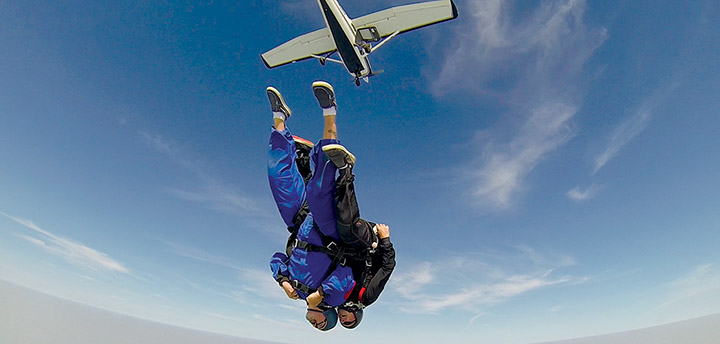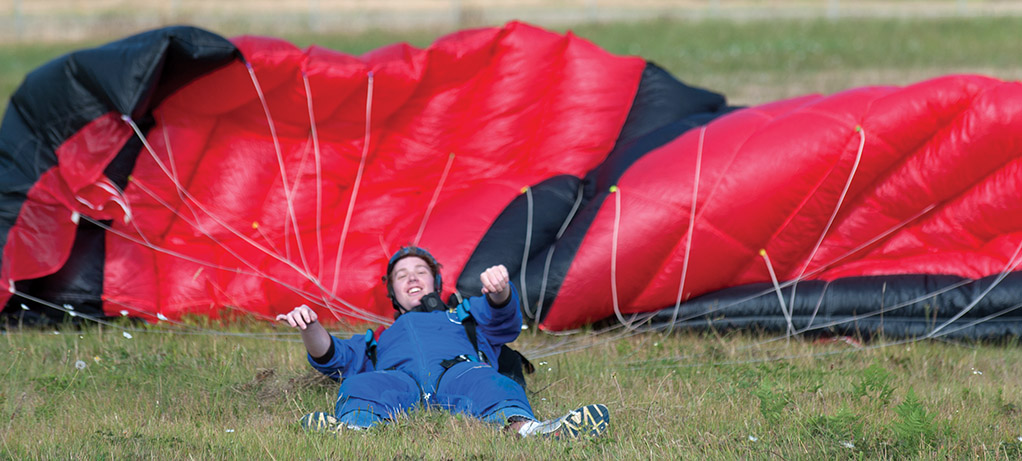As an airplane pilot, Roy Wharton was best known for losing his passengers before the plane landed.
But they kept coming back for more.
Wharton, 60, is co-founder and owner of Pacific Airsports Skydiving and patriarch of the ParaPacific Skydiving Club, both of which operate from a hangar at Campbell River Airport.
Pacific Airsports provides a variety of opportunities for would-be skydivers, from single bucket list leap strapped to a professional tandem skydiver to a 20-jump solo certification course. What it doesn’t provide is a huge income.
“I’m not in this business to make a pile of money,” said Wharton. “I’m in this business because I love skydiving. It’s my dream to see everybody, at least once, jump out of an airplane. Because it’s the coolest thing you can ever do.”
Wharton is a tall, spry man who can gush like an excited schoolboy about skydiving one moment, then turn around and deadpan one-liners about the lunacy of the sport the next.
“Jumping out of an airplane isn’t hard, physically,” he said. “But mentally, it’s a head trip. I mean, who jumps from an airplane? You’ve gotta be a little cuckoo to jump from an airplane.”
That doesn’t prevent the clientele from flocking to Campbell River, which Wharton has managed to turn into a drop zone (DZ) of note for those seeking entry into the sport.
Pacific Airsports has operated here since he moved the business from Comox in 1992. Until the past year, it was one of only two DZs on Vancouver Island, and in July became the first to offer a one-week, crash course class designed to give skydivers a shot at 20 jumps and their solo skydiving ticket.
“I was looking up skydiving on Vancouver Island and this popped up. I thought, oh, this looks perfect,” said Kyler Jones, 18, who ventured from Nanaimo for the weeklong course. “They have a zone in Qualicum where you can jump if you have your own gear. Here, they have all the student gear; everything is taken care of.”
Jones is a prime example of the type of person drawn to skydiving. A classic Type A personality who referees hockey at the provincial level and who had participated in rugby, lacrosse and hockey, he is scheduled to enlist in the Canadian Forces in September as a sapper — a combat engineer — where he can continue to jump.
“I like cliff-jumping and what-not,” said Jones. “This sounded like an adrenaline rush. I did a tandem (jump) for my 18th birthday just to see what it was like and loved it.
“I wanted to get my solo ticket because I think it’s a hobby I want to do.”
Then again, skydiving is not all about Type A. At the opposite end of the spectrum is Jones’s jump camp classmate, a Cobble Hill bartender who gave his name only as Rick.
“There really wasn’t much thought out, actually,” Rick said of his reason for signing up for the 20-jump course. “It seemed like it was going to be enjoyable, and I really value experiences over possessions.”
So what does Rick plan to do with his solo skydiving ticket once he achieves it?
“Well, (Jones) does a lot more planning than I do, to be honest with you,” he said. “I have a lot of ideas, but I like to live in the moment, to be honest.”
Pacific Airsports has had jumpers ranging in age from 18, the minimum allowed, to 84, Wharton said. And the range of responses to the experience is nearly as varied.
Invited to the one-day, first-jump course by friend Karina Gibson, Courtenay’s Joe Burnett was raring to go until he actually stepped out of the plane and hung from the wing strut. When jumpmaster Ron O’Reilly shouted for him to let go, Burnett’s hands did not accept the message. “I knew I was supposed to let go,” said Burnett. “But I couldn’t.”
 Before pilot Keegan Allen could fly the plane clear of the drop zone over the airport, O’Reilly helped Burnett with a little nudge. After Burnett floated to a rolling landing in the grassy field alongside the Pacific Airsports hangar, he shared a huge grin with classmate Tayo Wallenburg.
Before pilot Keegan Allen could fly the plane clear of the drop zone over the airport, O’Reilly helped Burnett with a little nudge. After Burnett floated to a rolling landing in the grassy field alongside the Pacific Airsports hangar, he shared a huge grin with classmate Tayo Wallenburg.
“I would so do that again,” Burnett said. That is music to the ears of Wharton and the jumpers who both work for the business and participate in skydiving as club members.
Jeff Warden, 52, as a search and rescue tech at CFB Comox who serves as a tandem instructor for Pacific Airsports, he said even the jumpers being paid to perform a job still have a passion for skydiving.
“More than anything, I like the idea of introducing people to the sport of skydiving,” Warden said. “Sure, I love to jump, but there are only so many things you can do in freefall and only so many things you can do flying the parachute.”
Scott Gurney was invited, along with a group of friends, by another friend who had taken the first jump course. It wasn’t until that friend died that Gurney and the rest of his buddies took the jump course in their fallen comrade’s honour.
“I’m the only one who stuck with it,” he said. “I like flying; you feel like Superman. Flying the parachute’s fun; the freefall is fun. It’s a great hobby.”
Gurney admits he is still more nervous about jumping than skydivers with a similar level of experience, but he believes it keeps him safe. Besides, the higher the plane climbs on each trip, the safer he feels.
“It’s all about time,” he said. “If the plane had a problem at 1,500 feet, we’re in trouble. If the plane has a problem at 5,000 feet, we jump out. Then it’s ‘Good luck, Keegan; see you later.'”
If things really went sideways, Keegan would probably be fine. Along with everyone else aboard the Cessna 182, he is equipped with a parachute and took the first-jump course before starting work as a pilot for Pacific Airsports earlier this year.
“It’s a lot of fun, probably the craziest five seconds I’ve ever experienced,” Allen said of his first free-fall.
First solo jumps are taken from 5,000 feet, with an instructor-assisted parachute release at 3,500 feet.
“We teach them to count to six, because that’s when they should be hanging under their parachute,” said Wharton. “If you’re not, you maybe got one of these ‘what-ifs’.”
A parachute failing to deploy is the big “what-if”, Wharton admits. But jumpers all have a backup chute and are trained to release the main chute and open the backup if there is a problem.
“We call it Plan B,” Wharton said. “There really isn’t a Plan C to speak of. Well, there is, but Plan C is more spiritual in nature.”
There have been the occasional sprained ankle or twisted knee, but Pacific Airsports has had only one serious incident in 38 years in business in Comox and Campbell River. In that incident, a student’s parachute opened but the lines were fouled and it was turning.
“For whatever reason, he didn’t get rid of it and come down under his backup chute,” Wharton said. “So he hit the ground pretty hard.” The jumper lived, but spent weeks in hospital with a broken pelvis and other injuries.
Wharton said the technology of parachuting has led to a change in the nature of skydiving accidents. With chutes getting smaller and smaller — and thereby faster and more maneuverable — more skydiving fatalities are occurring under perfectly good parachutes than because of a parachute’s failure.
“Back in my day the thrill was jumping out of the plane and doing the freefall,” he said. “The parachute was just a safe way to get back to the ground. Now, it’s fun jumping out, it’s fun in freefall, and it’s fun flying the chute.”
Wharton has been at it since 1972, when his parents took him to watch skydivers jump at an event at the Comox Rec Centre.
“Those four jumpers landed right in front of me, and I thought that was the coolest thing I’d ever seen,” Wharton said.
He began making inquiries, got a pamphlet from one of the jumpers and made a few calls. Within two weeks he was out at CFB Comox taking a skydiving course through the Comox Skydivers, a hybrid military/civilian club allowed to operate from the air base.
Within a year, he succumbed to a request by the owners of the club’s plane to get his pilot’s licence and fly jumpers for them. And within five years, when those owners decided to get out of the skydiving business, Wharton gathered four partners — including his father, an aircraft maintenance engineer with the Canadian Forces — who bought a plane and started a business.
In 1980, looking for another plane, Wharton found the plane he made his first jump from up for sale in Abbotsford. “I thought, come on home,” he said, “and we bought it.” It is still the plane used by the jump school today.
Pacific Airsports is not the only business Wharton has owned. For 34 years, he was owner of the Jolly Giant convenience store in Campbell River, and was living here when he decided to try moving his skydiving business from Comox in 1992. By then, he had bought out his other partners and brought in his brother, Reid, to join him and their father as co-owners.
“I met with the acting airport manager, and he was phenomenal,” Wharton said. “He said, ‘Yeah, I’m willing to give you guys a try; let’s see how it works.'”
After a year of working out of a truck and camper at the south end of the airport, Pacific Airsports leased a spot at the north end and erected the present-day hangar, which includes an office, a classroom and storage lockers for equipment. The business is affiliated with the Canadian Sport Parachuting Organization, through which its members receive training and certifications.
Its aircraft is licensed and regulated under Transport Canada. The only thing the skydiving club’s plane is not certified for is carrying passengers.
“The funny thing is, skydivers are not considered passengers,” said Wharton. “Skydivers are actually considered cargo, which kind of blows me away.
“I guess it’s because they go up, but they don’t come down with the plane.”
